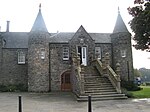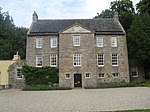Oldmeldrum
Villages in Aberdeenshire

Oldmeldrum (commonly known as Meldrum) is a village and parish in the Formartine area of Aberdeenshire, not far from Inverurie in North East Scotland. With a population of around 2,187, Oldmeldrum falls within Scotland's top 300 centres of population. Oldmeldrum is home to one of the oldest whisky distilleries in Scotland, Glen Garioch, which was built in 1797. Local industries are agriculture and engineering services connected to the oil industry in Aberdeen.
Excerpt from the Wikipedia article Oldmeldrum (License: CC BY-SA 3.0, Authors, Images).Oldmeldrum
Market Square,
Geographical coordinates (GPS) Address Nearby Places Show on map
Geographical coordinates (GPS)
| Latitude | Longitude |
|---|---|
| N 57.335 ° | E -2.32 ° |
Address
Market Square
AB51 0AA
Scotland, United Kingdom
Open on Google Maps







